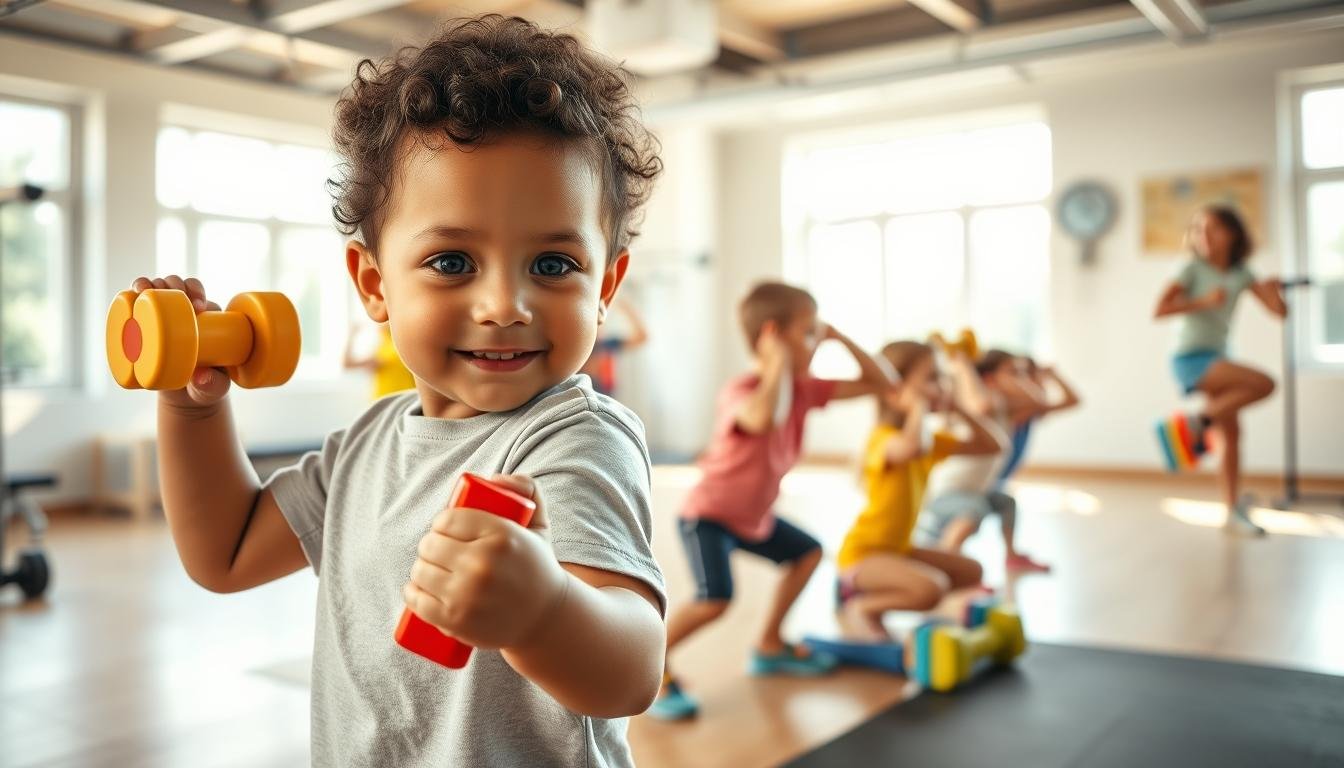Did you know that building a child’s strengths goes beyond just physical fitness? It’s about nurturing their emotional resilience, mental focus, and overall confidence. A holistic approach ensures they grow into well-rounded individuals ready to tackle life’s challenges.
Balancing structured activities with free play is key. While organized sports and exercises help, unstructured playtime fosters creativity and natural development. This combination not only enhances physical abilities but also boosts emotional and mental well-being.
Safety is the foundation of any effective strategy. Whether it’s exercise routines or dietary plans, ensuring age-appropriate methods is crucial. Parents play a vital role in guiding their child’s journey, helping them discover and nurture their unique strengths.
This article explores expert-recommended methods, from integrating play into daily routines to understanding the role of nutrition. By focusing on a balanced approach, you can help your child build confidence and prepare for lifelong success.
Key Takeaways
- A holistic approach supports physical, emotional, and mental growth.
- Balance structured activities with free play for natural development.
- Safety is essential in all strength-building strategies.
- Parental guidance helps identify and nurture a child’s strengths.
- Early development correlates with academic and life success.
Why Children’s Strength Matters for Development
Understanding the importance of a child’s abilities can shape their future in profound ways. Physical, emotional, and social skills all play a role in their growth. These strengths not only prepare them for school but also for life’s challenges.
Physical abilities, like motor skills, reduce injury risk by 42% and improve bone density. This foundation supports active lifestyles and sports participation later in life. Emotional resilience helps kids manage stress, boosting their classroom performance.
Social skills, such as cooperation and empathy, foster positive peer relationships. These traits are essential for teamwork and leadership. Studies show that strong executive functioning skills lead to 30% better academic outcomes.
Parents play a key role in identifying and nurturing these strengths. Early recognition allows for tailored educational approaches, setting kids up for success. Longitudinal studies link childhood development to adult wellness and career achievements.
By focusing on a child’s unique abilities, we can help them thrive in all areas of life. From academics to social interactions, these skills create a well-rounded individual ready for the future.
Key Components of Children’s Strength
Developing a child’s abilities involves more than just physical growth. It’s about nurturing their emotional and mental skills to create a well-rounded individual. These strengths work together to support their overall development and prepare them for life’s challenges.

Physical Strength
Physical abilities are the foundation of a child’s growth. Activities like pushing, pulling, and balancing help build fundamental movement patterns. These skills improve coordination, grip strength, and running speed.
Progressive overload principles ensure safe muscle development. This approach helps kids achieve age-appropriate milestones. Benefits include better posture, injury prevention, and enhanced athletic performance.
Emotional and Mental Strength
Emotional strength is just as important as physical abilities. It helps kids manage stress and build resilience. Skills like empathy and self-regulation foster positive peer relationships and teamwork.
Mental strength supports focus and decision-making. It’s essential for academic success and problem-solving. By nurturing these strengths, parents can help their child thrive in all areas of life.
Safe Exercises to Build Children’s Strength
Engaging in safe exercises helps kids develop essential skills while having fun. These activities are designed to improve their physical ability without compromising their well-being. Whether it’s bodyweight exercises or light weight training, the focus is always on safety and gradual progress.
Bodyweight Exercises
Bodyweight exercises are a great way to build foundational skills. Activities like bear crawls and crab walks engage the entire body, improving coordination and balance. These tasks are simple yet effective, making them perfect for kids of all ages.
Progressive plyometrics, such as box jumps starting at a 6-inch height, help develop explosive power. Obstacle courses combine strength and coordination, turning exercise into a fun challenge. Yoga poses, like the plank or tree pose, enhance core stability and flexibility.
Strength Training with Light Weights
Strength training with light weights can be safe and beneficial when done correctly. Focus on proper form and age-appropriate exercises. For example, using small dumbbells for bicep curls or resistance bands for squats can build muscle without strain.
Always supervise kids during these activities to ensure they maintain proper technique. Start with lighter weights and gradually increase as their ability improves. This approach helps them build confidence and reduces the risk of injury.
By incorporating these exercises into their routine, kids can develop essential skills while staying active and healthy. Whether at home or school, these activities provide a foundation for lifelong fitness.
Incorporating Play into Strength Building
Creative activities can transform strength-building into an adventure. By blending play with exercises, kids stay motivated while developing essential skills. This approach not only enhances physical abilities but also boosts social skills and communication.

Turn drills into superhero challenges or rescue missions. These narrative-based activities make movement exciting and engaging. Kids can build coordination and problem-solving skills while having fun.
Musical games, like freeze dance with squat holds, add rhythm to workouts. Changing tempos improve memory and coordination. These interests-driven games keep kids active and entertained.
Collaborative projects, such as building with natural materials, encourage teamwork. Peer-led stations promote leadership and learning. These activities foster creativity and a sense of accomplishment.
Imaginative play scenarios, like treasure hunts or solving puzzles, require physical and mental effort. Incorporating stories into routines makes strength-building a memorable experience. By blending play with exercises, kids develop lifelong habits in a fun and safe way.
Nutrition for Building Children’s Strength
Proper nutrition plays a crucial role in supporting a child’s growth and overall well-being. A balanced diet not only fuels their physical activities but also enhances their cognitive and emotional development. Parents and caregivers can take a proactive approach by understanding the essential nutrients and meal strategies that promote healthy habits.
Essential Nutrients
Protein is vital for muscle repair and growth. Kids aged 4-8 need about 13 grams daily, while those aged 9-13 require up to 34 grams. Dairy-free diets can include calcium-rich alternatives like fortified plant-based milk or leafy greens. Timing matters too—post-activity snacks with protein and carbs aid recovery.
Hydration is another key factor. Encourage kids to drink water before, during, and after physical activities. This simple habit supports energy levels and overall health. By focusing on these nutrients, parents can ensure their child’s body gets what it needs to thrive.
Healthy Snacks and Meals
Healthy snacks can be both tasty and nutritious. Options like apple slices with peanut butter or yogurt with berries provide energy without added sugars. Meals should include a mix of lean proteins, whole grains, and colorful vegetables to cover all nutritional bases.
Involving kids in meal prep can spark their interest in healthy eating. Let them choose ingredients or help with simple tasks. This hands-on approach not only teaches valuable life skills but also encourages them to try new things. With the right information and strategies, parents can make nutrition a fun and rewarding part of their child’s daily routine.
Safety Tips for Strength Training in Children
Ensuring safety during strength training is essential for kids to develop skills without risks. Proper guidance and age-appropriate methods can help them build confidence while avoiding injuries. Parents and coaches play a key role in creating a safe environment for these activities.
Proper Form and Technique
Teaching kids the correct form is the foundation of safe training. Neutral spine alignment, for example, prevents back strain during exercises. Cueing techniques, like verbal reminders, help kids maintain proper posture.
Common form errors, such as knee valgus during squats, can lead to injuries. Using video analysis tools allows for real-time feedback on technique. Spotting procedures are also crucial when introducing new movements to ensure safety.
Age-Appropriate Activities
Not all exercises are suitable for every age group. Younger kids benefit from bodyweight tasks like bear crawls or crab walks. These activities improve coordination without overloading their muscles.
As kids grow, they can gradually incorporate light weights or resistance bands. Supervision is key to ensure they perform exercises the right way. This approach helps them build skills while minimizing weaknesses in their technique.
By focusing on safety and proper guidance, kids can enjoy strength training while staying healthy. These habits set the stage for a lifelong love of fitness.
Encouraging a Lifelong Love for Fitness
Fostering a love for movement helps kids develop confidence and resilience. By making fitness fun and engaging, parents can instill habits that last a lifetime. A balanced approach ensures kids stay active while enjoying the process.
Family fitness challenges are a great way to get everyone involved. Set goals like walking 10,000 steps daily or completing a 30-day yoga challenge. Reward systems, such as stickers or small prizes, keep kids motivated and excited about their activities.
Technology can also play a role in encouraging movement. Fitness trackers designed for kids help them monitor their progress and set personal goals. These tools make fitness feel like a game, boosting their confidence and sense of accomplishment.
Community events, like fun runs or park cleanups, provide opportunities to connect with others. These activities teach teamwork and responsibility while promoting physical health. Kids learn that fitness can be both fun and meaningful.
Growth journaling is another effective strategy. Encourage kids to track their milestones, like running faster or lifting more. This practice helps them see their progress and builds a sense of pride in their abilities.
Parents can lead by example by partnering with their kids in workouts. Whether it’s a morning jog or a yoga session, these shared moments create lasting memories. This approach shows kids that fitness is a valuable part of life.
Finally, let kids explore different interests to discover what they enjoy. From dance to martial arts, varied activities help them find their passion. This exploration sets the stage for lifelong success in staying active and healthy.
Conclusion
Helping a child grow into their best self requires a balanced approach. Combining physical activity, proper nutrition, and emotional support creates a strong foundation for their development. Parents play a key role in guiding this journey, ensuring their child feels encouraged and confident.
Remember to maintain a 3:1 ratio of praise to constructive feedback. This balance helps build their strengths while addressing areas for improvement. Celebrate small victories along the way, as these moments boost motivation and self-esteem.
For continued learning, explore resources like books or apps focused on child growth. Gradual, consistent progress is more effective than rushing results. Consider a personalized assessment to tailor activities to your child’s unique needs.
Finally, consult a pediatrician to design a safe and effective program. With the right support, your child can thrive in school and life, building strengths that last a lifetime.
FAQ
Why is physical strength important for kids?
Physical strength helps kids develop better coordination, improves their confidence, and supports healthy growth. It also prepares them for daily activities and sports.
How can I help my child build emotional and mental strength?
Encourage open communication, teach problem-solving skills, and provide opportunities for them to express their feelings. Positive reinforcement and empathy also play a big role.
What are some safe exercises for kids to build strength?
Bodyweight exercises like push-ups, squats, and planks are great. Light weights or resistance bands can also be used under supervision to ensure safety.
How can play help in building strength?
Play activities like climbing, jumping, and running naturally engage muscles and improve physical abilities. It also makes fitness fun and less like a chore.
What nutrients are essential for building strength in kids?
Protein, calcium, iron, and vitamins like D and B12 are crucial. These nutrients support muscle growth, bone health, and overall energy levels.
Are there any safety tips for kids doing strength training?
Always focus on proper form and technique. Start with age-appropriate activities and avoid heavy weights. Supervision is key to prevent injuries.
How can I encourage my child to love fitness?
Make fitness fun by incorporating games, family activities, and sports. Praise their efforts and set a positive example by staying active yourself.
Can strength training stunt a child’s growth?
No, when done correctly with proper guidance, strength training is safe and does not affect growth. Focus on light weights and controlled movements.






